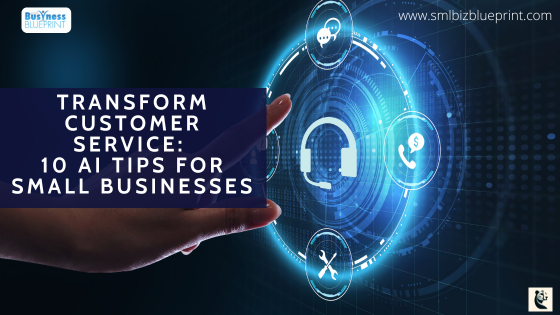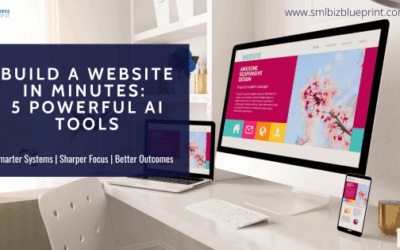In today’s competitive market, delivering exceptional customer service is crucial for small businesses striving to compete with larger companies. One powerful tool that can help achieve this is Artificial Intelligence (AI).
By leveraging AI in customer service, small businesses can enhance efficiency, personalise interactions, and provide faster response times, all while keeping costs manageable.
This blog post will delve into the practical benefits of AI customer service tools, reassuring you that implementing AI in your small business is feasible.
We will discuss how AI-driven chatbots can improve response times and provide insights into cost-effective AI solutions.
Additionally, we’ll cover how AI can help personalise customer interactions, automate routine tasks, and handle complaints more efficiently.
By the end of this post, you’ll have a comprehensive understanding of how AI can transform your customer service strategy, making your small business more competitive and customer-centric.

#1 Improve Response Times with AI Chatbots
In the fast-paced world of customer service, response times can make or break customer satisfaction. AI chatbots have emerged as powerful tools for enhancing efficiency and improving response times for small businesses.
By providing instant responses and handling multiple inquiries simultaneously, AI chatbots ensure that customers receive timely support, essential for maintaining a competitive edge.
How AI Chatbots Work
AI chatbots are software programs that simulate human conversation using natural language processing (NLP). They can understand, interpret, and respond to real-time customer queries.
Chatbots can continuously improve their responses using machine learning algorithms based on past interactions.
Benefits of Using AI Chatbots
- 24/7 Availability: Unlike human agents, AI chatbots are available around the clock. This means customers can get their questions answered anytime, even outside of business hours.
- Instant Responses: Chatbots provide immediate answers to common questions, significantly reducing customer wait times.
- Scalability: AI chatbots can handle unlimited inquiries simultaneously, making them ideal for small businesses with high customer interaction volumes.
- Cost Efficiency: Implementing AI chatbots can reduce the need for a large customer service team, leading to cost savings.
Popular AI Chatbot Tools for Small Businesses
Chatfuel: A user-friendly platform that allows small businesses to create AI chatbots for Facebook Messenger without coding.
Tars: A chatbot builder designed to help businesses improve customer engagement and conversion rates.
Drift: A conversational marketing platform that uses AI to engage website visitors and convert them into leads.
Tips for Implementing AI Chatbots Effectively
- Define Your Objectives: Clearly outline the goals you want to achieve with your AI chatbot, such as improving response times, increasing customer satisfaction, or reducing operational costs.
- Choose the Right Platform: Select an AI chatbot tool that aligns with your business needs and integrates seamlessly with your existing systems.
- Train Your Chatbot: Ensure your chatbot is well-trained to handle common customer inquiries. Regularly update its knowledge base to improve its responses.
- Monitor and Optimize: Monitor your chatbot’s performance and make necessary adjustments based on customer feedback and interaction data.
By incorporating AI chatbots into your customer service strategy, your small business can provide faster, more efficient support, ultimately leading to happier customers and a stronger competitive position.
#2 Personalize Customer Interactions with AI
Personalisation is key to enhancing customer satisfaction and building loyalty in today’s competitive market. AI technology enables small businesses to offer personalised customer service experiences by analysing customer data and tailoring interactions to meet individual needs.
This approach not only improves customer engagement but also fosters long-term relationships.
How AI Personalization Works
AI-driven personalisation involves using algorithms to analyse customer data, such as purchase history, browsing behaviour, and interaction patterns.
By understanding these data points, AI can predict customer preferences and provide tailored recommendations and support.
Benefits of Personalizing Customer Interactions with AI
- Enhanced Customer Experience: Personalized interactions make customers feel valued and understood, increasing satisfaction.
- Increased Customer Loyalty: Customers who receive tailored recommendations and support are more likely to return and remain loyal to your business.
- Higher Conversion Rates: Personalization can drive higher conversion rates by presenting customers with products and services that match their interests.
- Efficient Marketing: AI can segment customers based on their behaviour and preferences, allowing for more targeted and effective marketing campaigns.
Practical Examples of AI-Driven Personalization
- Product Recommendations: AI can analyse past purchases to recommend products a customer will likely buy. For example, an online bookstore can use AI to suggest books based on a customer’s reading history.
- Personalised Email Campaigns: AI can tailor email content to individual customers, increasing the likelihood of engagement and conversion. For instance, a fashion retailer can send personalised emails showcasing new arrivals that match a customer’s style preferences.
- Dynamic Website Content: AI can customise website content in real-time based on a visitor’s behaviour and preferences. An e-commerce site, for example, can display personalised product recommendations on the homepage.
AI Tools for Personalizing Customer Interactions
Segment: A customer data platform that helps businesses collect, unify, and act on customer data to create personalised experiences.
Dynamic Yield: A personalisation platform that uses machine learning to deliver personalised customer journeys across the web, mobile, email, kiosks, IoT, and call centres.
Monetate: A personalisation and customer experience optimisation platform that allows businesses to test, target, and personalise content and offers.
Tips for Leveraging AI for Personalization
- Gather and Analyze Customer Data: Collect data from various touchpoints, such as website interactions, purchase history, and social media engagement, to build a comprehensive customer profile.
- Use Segmentation: Segment your customer base into different groups based on behaviour, preferences, and demographics to deliver more targeted and relevant experiences.
- Implement Real-Time Personalization: Use AI to adjust real-time content and recommendations based on customer interactions dynamically.
- Monitor and Adjust: Continuously track the performance of your personalisation efforts and make necessary adjustments to improve effectiveness.
By leveraging AI to personalise customer interactions, your small business can create more meaningful and engaging experiences, ultimately leading to higher customer satisfaction and loyalty.
#3 Implement Cost-Effective AI Solutions
For many small businesses, the cost is a significant factor when considering new technologies. Fortunately, AI solutions have become more accessible and affordable, allowing small businesses to enhance customer service without breaking the bank.
Implementing cost-effective AI tools can help small businesses improve efficiency, reduce operational costs, and provide better customer experiences.
Affordability and Scalability of AI Solutions
One of AI technology’s major advantages is its scalability. Many AI tools offer tiered pricing models, allowing businesses to start with basic features and expand as their needs grow.
This approach ensures small businesses can afford AI solutions tailored to their requirements.
Cost-Effective AI Tools and Services
Chatfuel: This platform allows small businesses to create AI chatbots for Facebook Messenger without needing any coding skills. Its free and premium plans cater to different business needs.
Freshdesk: A cloud-based customer support software that offers AI-driven features like chatbots and automated ticketing at a competitive price. Freshdesk’s scalable pricing plans make it an excellent choice for small businesses.
Zoho Desk: An AI-powered helpdesk software that provides automation features to streamline customer service processes. Zoho Desk’s flexible pricing options make it accessible for small businesses.
Choosing the Right AI Solutions for Your Business
- Identify Your Needs: Identify the specific customer service challenges your business faces. These could range from handling high volumes of inquiries to personalising customer interactions.
- Research AI Tools: Look for AI tools that address your needs and fit your budget. Consider features, pricing plans, and customer reviews to make an informed decision.
- Leverage Free Trials: Many AI solution providers offer free trials or freemium plans. Utilise these options to test the tools before making a financial commitment.
- Consider Integration: To avoid additional costs, ensure that the AI tools you choose can integrate seamlessly with your existing systems and platforms.
Best Practices for Implementing Cost-Effective AI Solutions
- Start Small: Begin with basic AI features and gradually expand as your business grows and your needs evolve.
- Train Your Team: Ensure your team is well-trained to use the AI tools effectively. Regular training sessions can help staff stay updated with new features and best practices.
- Monitor Performance: Monitor your AI solutions’ performance to identify improvement areas. Use analytics and customer feedback to make data-driven decisions.
- Seek Expert Advice: Consult with AI experts or service providers to maximise your AI investments.
By carefully selecting and implementing cost-effective AI solutions, your small business can enhance customer service operations, improve efficiency, and stay competitive without significant financial strain.

#4 Use AI to Analyze Customer Feedback
Understanding customer feedback is crucial for any business aiming to improve its services and customer satisfaction. AI technology can help small businesses collect and analyse customer feedback efficiently, providing valuable insights that drive better decision-making and service enhancements.
By leveraging AI for feedback analysis, small businesses can stay attuned to customer needs and preferences, ultimately fostering a more customer-centric approach.
The Role of AI in Customer Feedback Analysis
AI tools can process large volumes of customer feedback from various sources, such as surveys, reviews, social media, and support tickets. These tools use natural language processing (NLP) and machine learning algorithms to identify patterns, sentiments, and common issues, providing a comprehensive understanding of customer opinions.
Benefits of Analyzing Customer Feedback with AI
- Quick and Accurate Analysis: AI can quickly sift through large datasets, providing accurate insights much faster than manual analysis.
- Sentiment Analysis: AI can determine the sentiment behind customer comments, helping businesses understand how customers feel about their products or services.
- Identifying Trends and Patterns: AI can highlight recurring themes and issues, allowing businesses to address common concerns and improve overall service quality.
- Actionable Insights: The detailed insights AI provides can inform strategic decisions and help businesses prioritise areas for improvement.
AI Tools for Customer Feedback Analysis
MonkeyLearn: An AI-powered text analysis tool that can categorise and extract insights from customer feedback, helping businesses understand sentiment and identify key topics.
Clarabridge: A customer experience management platform that uses AI to analyse feedback from multiple channels, providing actionable insights and reporting.
Qualtrics XM: An experience management platform that leverages AI to analyse customer feedback and deliver detailed reports on customer sentiment and trends.
Steps to Implement AI for Customer Feedback Analysis
- Collect Feedback from Multiple Channels: Gather customer feedback from various sources, including surveys, social media, reviews, and support tickets, to get a holistic view of customer opinions.
- Choose the Right AI Tool: Select an AI tool that fits your business needs and budget. Look for features like sentiment analysis, text categorisation, and trend identification.
- Integrate with Existing Systems: Ensure the AI tool integrates seamlessly with your current systems to streamline data collection and analysis.
- Analyse and Act on Insights: Review the AI tool’s insights regularly and take actionable steps to address identified issues and improve customer satisfaction.
Best Practices for Using AI in Customer Feedback Analysis
- Regularly Update Your AI Tool: Keep your AI tool’s knowledge base updated with new feedback to ensure it provides accurate and relevant insights.
- Combine AI Insights with Human Judgment: While AI can identify patterns and trends, human judgment is essential for interpreting these insights and making strategic decisions.
- Act on Feedback Promptly: Address issues and implement improvements based on customer feedback to show customers that their opinions are valued.
- Monitor Results: Continuously monitor the impact of changes made based on AI insights to ensure they lead to the desired improvements in customer satisfaction.
By utilising AI to analyse customer feedback, your small business can better understand customer needs and preferences, leading to better service, increased satisfaction, and stronger customer loyalty.
#5 Automate Routine Customer Service Tasks
Managing routine customer service tasks for small businesses can be time-consuming and resource-intensive. AI technology offers a solution by automating these tasks, allowing staff to focus on more complex and value-added activities.
Automating routine tasks improves efficiency and enhances the overall customer experience by providing faster and more consistent service.
Advantages of Automating Routine Tasks with AI
- Increased Efficiency: AI can handle repetitive tasks quickly and accurately, freeing up human agents to tackle more complex issues.
- Cost Savings: Automation reduces the need for additional staff, lowering operational costs.
- Consistency: AI ensures that responses to routine inquiries are consistent, reducing the risk of errors and improving customer satisfaction.
- Scalability: Automated systems can easily scale to handle increased volumes of inquiries without compromising service quality.
Common Routine Tasks That Can Be Automated
- Answering FAQs: AI can respond instantly to frequently asked questions about store hours, return policies, and product information.
- Order Tracking: AI can automatically update customers on the status of their orders, including shipping notifications and delivery estimates.
- Appointment Scheduling: AI can handle booking and rescheduling appointments, ensuring a seamless experience for customers.
- Customer Onboarding: AI can guide new customers through onboarding processes like account setup and product tutorials.
AI Tools for Automating Routine Customer Service Tasks
Intercom: A customer messaging platform that uses AI to automate responses to common questions and support requests.
Zendesk: A customer service software that offers AI-powered automation features for ticketing, chat, and knowledge base management.
HubSpot Service Hub: An AI-driven customer service platform that automates routine tasks like ticketing, email responses, and customer follow-ups.
Steps to Implement AI for Automating Routine Tasks
- Identify Routine Tasks: Start by identifying the repetitive tasks that take up significant time and resources in your customer service operations.
- Choose the Right AI Tool: Select an AI tool with the necessary features to automate these tasks. Consider factors like ease of use, integration capabilities, and cost.
- Set Up Automation Rules: Define the rules and workflows for your AI tool to follow when handling routine tasks. Ensure these rules align with your customer service standards.
- Monitor and Optimize: Continuously monitor the performance of your AI automation and make adjustments as needed to improve efficiency and customer satisfaction.
Best Practices for Automating Routine Customer Service Tasks
- Start with High-Impact Tasks: Automate tasks significantly impacting efficiency and customer satisfaction.
- Test and Refine: Thoroughly test your AI automation processes before full implementation. Gather feedback from customers and staff to identify areas for improvement.
- Maintain Human Oversight: Ensure human agents can handle complex or sensitive issues requiring a personal touch.
- Keep Customers Informed: Clearly communicate to customers when interacting with an AI system and provide options to connect with a human agent if needed.
By automating routine customer service tasks with AI, your small business can improve efficiency, reduce costs, and enhance the overall customer experience.
This approach allows you to allocate resources to complex and strategic activities, ensuring your customer service remains top-notch.
#6 Enhance Customer Support with AI-Driven Insights
In the age of data, leveraging AI to gain valuable insights into customer behaviour and preferences is crucial for enhancing customer support.
AI-driven insights can help small businesses make data-driven decisions, personalise customer interactions, and proactively address issues, ultimately improving customer satisfaction and loyalty.
The Importance of Data-Driven Decision-Making
Data-driven decision-making involves using insights derived from data analysis to inform business strategies and actions. AI can process vast amounts of data quickly, identifying patterns and trends that may not be immediately apparent.
This allows small businesses to make informed decisions that enhance customer support and service quality.
Benefits of Using AI for Customer Insights
- Improved Understanding of Customer Needs: AI can analyse customer data to reveal preferences, pain points, and behaviour patterns, providing a deeper understanding of customer needs.
- Personalised Customer Interactions: With AI-driven insights, businesses can tailor their interactions to individual customers, offering personalised recommendations and support.
- Proactive Issue Resolution: AI can predict potential issues before they arise, enabling businesses to address them proactively and prevent customer dissatisfaction.
- Enhanced Marketing Strategies: AI insights can inform more effective marketing campaigns by identifying target audiences and preferred communication channels.
AI Tools for Gaining Customer Insights
Google Analytics: A powerful tool that uses AI to provide insights into website traffic, customer behaviour, and marketing effectiveness.
Salesforce Einstein: An AI-powered platform that offers predictive analytics and personalised customer insights to enhance sales and customer service strategies.
HubSpot: An all-in-one CRM platform that leverages AI to analyse customer interactions and provide actionable insights for improving support and engagement.
Steps to Leverage AI-Driven Insights for Customer Support
- Collect Comprehensive Customer Data: Gather data from various touchpoints, such as website interactions, social media, purchase history, and customer support interactions.
- Implement AI Tools: Use AI tools to analyse the collected data and generate insights. Choose tools that align with your business needs and integration capabilities.
- Analyse and Interpret Insights: Review the insights provided by AI to understand customer preferences, behaviours, and potential issues.
- Act on Insights: Use the insights to proactively inform customer support strategies, personalise interactions, and address identified issues.
Best Practices for Using AI-Driven Insights
- Ensure Data Privacy: Protect customer data by following data privacy regulations and best practices.
- Combine AI with Human Intuition: While AI provides valuable insights, human intuition and experience are essential for interpreting and acting on these insights effectively.
- Regularly Update Data: Keep your data and AI tools updated to ensure the insights remain relevant and accurate.
- Monitor and Adjust: Continuously monitor the impact of changes made based on AI insights and adjust your strategies as needed to achieve the best results.
By leveraging AI-driven insights, small businesses can enhance customer support operations, provide personalised experiences, and make informed decisions that drive customer satisfaction and loyalty.
This data-driven approach ensures that your business remains responsive to customer needs and competitive.

#7 Handle Customer Complaints Efficiently with AI
Handling customer complaints efficiently is crucial for maintaining customer satisfaction and loyalty. AI can play a significant role by quickly identifying, prioritising, and resolving issues, allowing small businesses to provide prompt and effective customer service.
By leveraging AI, small businesses can improve their complaint management process, which can lead to happier customers and a stronger reputation.
How AI Enhances Complaint Management
AI can streamline complaint management by analysing customer communications using natural language processing (NLP) and machine learning algorithms. These technologies help identify the nature and urgency of complaints, enabling businesses to respond more effectively.
Benefits of Using AI for Complaint Handling
- Quick Identification of Issues: AI can rapidly analyse customer messages to detect complaints and categorise them based on severity and type.
- Prioritisation of Urgent Cases: AI tools can prioritise complaints that require immediate attention, ensuring that critical issues are addressed promptly.
- Efficient Routing: AI can automatically route complaints to the appropriate department or personnel, reducing response times and improving resolution rates.
- Consistent Responses: AI-driven systems can provide consistent and accurate responses to common complaints, ensuring a uniform customer experience.
AI Tools for Managing Customer Complaints
Zendesk: An AI-powered customer service platform that automates ticketing and complaint handling, ensuring that issues are quickly identified and resolved.
Freshdesk: A customer support software that uses AI to analyse and prioritise complaints, streamlining the resolution process.
Salesforce Service Cloud: An AI-driven customer service solution offering advanced analytics and automation features to manage and resolve customer complaints efficiently.
Steps to Implement AI for Handling Customer Complaints
- Identify Common Complaints: Analyze past customer interactions to identify common complaints and frequently arising issues.
- Choose the Right AI Tool: To manage complaints effectively, select an AI tool that offers features like sentiment analysis, prioritisation, and automated routing.
- Set Up Automation Rules: Define rules and workflows for the AI tool to follow when handling complaints, ensuring that urgent issues are prioritised and routed correctly.
- Monitor and Optimize: Monitor the AI tool’s performance and adjust to improve complaint resolution times and customer satisfaction.
Best Practices for Using AI in Complaint Handling
- Provide Clear Communication Channels: Ensure customers can access channels for lodging complaints, such as email, chat, and social media.
- Train Staff on AI Tools: Educate your staff on how to use AI tools effectively for complaint management, ensuring they can intervene when necessary.
- Combine AI with Human Oversight: While AI can handle many aspects of complaint management, human oversight is essential for complex or sensitive issues.
- Regularly Review and Update Processes: Review the AI tool’s performance and update workflows and automation rules based on customer feedback and emerging trends.
Integrating AI into your complaint management process allows your small business to handle customer complaints more efficiently, leading to faster resolutions, improved customer satisfaction, and a stronger reputation for excellent customer service.
#8 Train Your Staff on AI Customer Service Tools
For small businesses, the successful implementation of AI customer service tools depends on the technology itself and the staff’s ability to use these tools effectively.
Proper training ensures employees can leverage AI to enhance customer service, improving efficiency and customer satisfaction.
Investing in staff training is crucial for maximising the benefits of AI and fostering a culture of continuous improvement.
The Importance of Staff Training for AI Implementation
Training your staff on AI customer service tools helps them understand the technology’s capabilities and limitations. Well-trained employees can use AI tools more effectively, providing better service and addressing customer issues promptly.
Moreover, training fosters a sense of confidence and competence among employees, encouraging them to embrace new technologies.
Benefits of Training Staff on AI Tools
- Enhanced Efficiency: Proper training enables staff to use AI tools efficiently, streamlining customer service operations and reducing response times.
- Improved Customer Experience: Trained employees can leverage AI to provide personalised and accurate responses, enhancing the overall customer experience.
- Increased Adoption: Training ensures that staff are comfortable with AI tools, leading to higher adoption rates and more effective implementation.
- Continuous Improvement: Ongoing training helps employees stay updated with new features and best practices, ensuring continuous improvement in customer service.
Steps to Train Your Staff on AI Customer Service Tools
- Identify Training Needs: Assess the current skill levels of your staff and identify the specific areas where training is needed. Focus on the features and functionalities of the AI tools that are most relevant to your business.
- Develop a Training Plan: Create a structured training plan that includes comprehensive training sessions, hands-on practice, and assessments. Ensure the plan covers all aspects of the AI tools, from basic functions to advanced features.
- Use Multiple Training Methods: Incorporate various training methods, such as online courses, workshops, webinars, and one-on-one coaching, to cater to different learning styles.
- Provide Ongoing Support: Offer continuous support and resources, such as user manuals, FAQs, and a helpdesk, to assist employees in using the AI tools in their daily tasks.
Training Resources and Tools
- Vendor-Supplied Training: Many AI tool vendors offer training programs, tutorials, and resources to help businesses get started. Leverage these materials to ensure comprehensive training.
- Online Learning Platforms: Coursera, Udemy, and LinkedIn Learning offer courses on AI and customer service tools. Enroll your staff in relevant courses to build their skills.
- Internal Training Programs: Develop in-house training programs tailored to your business needs. Use experienced staff members to lead training sessions and share their knowledge.
Best Practices for Training Staff on AI Tools
- Start with the Basics: Start with foundational training to ensure all staff members understand the AI tools’ basic functions and capabilities.
- Encourage Hands-On Practice: Provide opportunities for hands-on practice to help employees become comfortable using the tools in real-life scenarios.
- Regularly Update Training Programs: Keep training programs updated with new features and best practices to ensure staff are always equipped with the latest knowledge.
- Foster a Learning Culture: Provide access to additional resources and training opportunities to encourage continuous learning and professional development.
By investing in comprehensive staff training, your small business can ensure the successful implementation of AI customer service tools.
Well-trained employees can leverage AI to provide superior customer service, leading to increased efficiency, customer satisfaction, and business growth.
#9 Integrate AI Customer Service Software Seamlessly
Integrating AI customer service software into existing systems is essential for small businesses to fully reap AI technology’s benefits.
A seamless integration ensures that AI tools work harmoniously with current processes and platforms, enhancing efficiency and providing a smooth experience for staff and customers.
Proper integration is crucial for maximising the functionality and effectiveness of AI customer service solutions.
The Importance of Seamless Integration
Seamless integration of AI customer service software allows businesses to automate and streamline their operations without disrupting existing workflows.
It ensures that data flows smoothly between systems, providing a unified view of customer interactions and enabling more efficient and effective service delivery.
Benefits of Seamless Integration
- Improved Efficiency: Integrated systems reduce the need for manual data entry and ensure that information is easily accessible, leading to faster response times and more efficient operations.
- Enhanced Customer Experience: Seamless integration allows consistent and personalised interactions across all customer touchpoints, improving the overall customer experience.
- Data Consistency: Integrated systems ensure customer data is consistent and up-to-date across all platforms, reducing errors and improving decision-making.
- Scalability: Integrated AI tools can easily scale with your business, accommodating growth without requiring significant changes to existing systems.
Steps to Achieve Seamless Integration
- Assess Existing Systems: Evaluate your current customer service systems and processes to identify areas where AI integration can add value. Determine the compatibility of your existing platforms with AI tools.
- Choose Compatible AI Tools: Select AI customer service software compatible with your current systems. Look for tools that offer robust integration capabilities and support common platforms used in your business.
- Plan the Integration Process: Develop a detailed integration plan that outlines the steps, timeline, and resources required for seamless integration. Involve key stakeholders in the planning process to ensure alignment and support.
- Test the Integration: Conduct thorough testing to ensure the AI tools integrate smoothly with your existing systems. Identify and address any issues before full deployment.
- Train Staff on New Systems: Provide comprehensive training to your staff on integrated AI systems, ensuring they understand how to use the new tools effectively and efficiently.
- Monitor and Optimize: Continuously monitor the performance of the integrated systems and make adjustments as needed to optimise functionality and address any emerging issues.
Best Practices for Seamless AI Integration
- Start with a Pilot Program: Begin the integration process with a pilot program to test the AI tools in a controlled environment. Use feedback from the pilot to make necessary adjustments before a full-scale rollout.
- Ensure Data Security: Protect customer data during integration by implementing robust security measures and complying with data privacy regulations.
- Collaborate with IT Support: Work closely with your IT team or external IT support to address technical challenges and ensure a smooth integration process.
- Maintain Clear Communication: Keep all stakeholders informed throughout the integration process. Clear communication helps manage expectations and ensures everyone is aligned with the integration goals.
By seamlessly integrating AI customer service software with existing systems, small businesses can enhance efficiency, improve customer experiences, and achieve greater scalability.
This approach enables businesses to leverage AI’s capabilities fully, driving better customer service outcomes and supporting business growth.

#10 Overcome Challenges of Implementing AI in Customer Service
Implementing AI in customer service can transform how small businesses operate, but it also comes with its own challenges.
Understanding these challenges and addressing them proactively is crucial for successful AI adoption.
By recognising potential obstacles and finding effective solutions, small businesses can fully leverage AI to enhance customer service and gain a competitive edge.
Common Challenges in AI Implementation
- Cost of Implementation: While AI tools have become more affordable, the initial cost of implementation can still be a barrier for small businesses.
- Technical Complexity: Implementing AI requires certain technical expertise, which small businesses may lack.
- Data Quality and Integration: AI relies on high-quality data to function effectively. Ensuring data accuracy and integrating AI with existing systems can be challenging.
- Employee Resistance: Staff may resist adopting new technologies due to fear of change or job displacement.
- Maintenance and Upgrades: AI systems require ongoing maintenance and updates to remain effective, which can be resource-intensive.
Strategies to Overcome These Challenges
- Start Small and Scale Gradually: Begin with a pilot project to test AI tools and demonstrate their value. Focus on the specific customer service area that will benefit most from AI and gradually scale up based on the results.
- Invest in Training and Support: Provide comprehensive training to staff to help them understand and embrace AI tools. Ongoing support and resources can ease the transition and encourage adoption.
- Choose Cost-Effective Solutions: Look for AI tools that offer tiered pricing, allowing you to start with basic features and expand as your budget allows. Open-source AI platforms can also provide cost-effective alternatives.
- Ensure Data Quality: Invest in data management practices to ensure the accuracy and completeness of your data. Clean and well-organized data is essential for effective AI performance.
- Seek Expert Advice: If you lack in-house expertise, consider consulting with AI specialists or service providers. They can help with the technical aspects of implementation and guide best practices.
- Monitor and Optimize: Continuously monitor the performance of your AI systems and make adjustments as needed. Regularly update your AI tools to utilise the latest features and improvements.
Best Practices for Overcoming AI Implementation Challenges
- Communicate the Benefits: Explain to your team the benefits of AI, highlighting how it will improve their workflow and enhance customer service.
- Involve Staff Early: Involve employees in the AI implementation process. Seek their input and address their concerns to foster a sense of ownership and acceptance.
- Plan for Change Management: Develop a change management plan to address the human side of AI implementation. This plan should include strategies for communication, training, and support.
- Set Realistic Expectations: Set realistic expectations for what AI can achieve and the timeline for seeing results. Understand that AI implementation is a gradual process that requires ongoing effort and adjustment.
By proactively addressing the challenges of AI implementation, small businesses can successfully integrate AI into their customer service operations.
This approach ensures businesses can fully realise AI’s benefits, leading to improved efficiency, enhanced customer experiences, and a stronger competitive position.
Conclusion
As explored in this blog post, leveraging AI to enhance customer service offers numerous benefits for small businesses.
AI technology can transform small businesses’ operations, from improving response times with AI chatbots and personalising customer interactions to implementing cost-effective solutions and automating routine tasks.
Small businesses can significantly improve their customer service operations by using AI to analyse customer feedback, enhance support with data-driven insights, efficiently handle complaints, and seamlessly integrate customer service software.
However, implementing AI comes with challenges, including cost, technical complexity, and employee resistance. By starting small, investing in training, ensuring data quality, and seeking expert advice, small businesses can overcome these challenges and fully realise the benefits of AI.
Now is the time for small businesses to embrace AI technology and stay competitive. By leveraging AI, you can provide exceptional customer service, foster customer loyalty, and drive business growth.
Ready to take your customer service to the next level? Explore AI solutions today and see how they can transform your small business.
Whether you’re looking to implement AI chatbots, personalise customer interactions, or streamline your complaint management process, an AI tool is perfect for your needs.
Don’t wait – begin your AI journey now and experience the benefits of enhanced customer service.
FAQs
Q1: What are the main benefits of using AI in customer service for small businesses?
A2: AI in customer service can significantly improve response times, enhance customer satisfaction through personalised interactions, reduce operational costs by automating routine tasks, provide valuable customer insights, and ensure consistent and accurate responses.
Q2: How can AI chatbots improve customer service response times?
A2: AI chatbots can respond instantly to customer inquiries, handle multiple conversations simultaneously, and operate 24/7. This ensures that customers receive timely support without waiting for a human agent.
Q3: What are some cost-effective AI solutions suitable for small businesses?
A3: Cost-effective AI solutions for small businesses include Chatfuel for creating chatbots on Facebook Messenger, Freshdesk for customer support automation, and Zoho Desk for helpdesk management. These tools offer scalable pricing plans and are user-friendly.
Q4: How can AI be used to personalise customer interactions?
A4: AI can analyse customer data to understand preferences and behaviours, allowing businesses to offer personalised product recommendations, tailor marketing messages, and provide customised support. This leads to higher customer satisfaction and loyalty.
Q5: What steps should small businesses take to train their staff on AI customer service tools?
A5: Small businesses should assess training needs, develop a structured training plan, use various training methods (such as online courses and workshops), provide ongoing support, and involve staff in the implementation process to ensure effective training.
Q6: How can small businesses integrate AI customer service software seamlessly with existing systems?
A6: To ensure seamless integration, small businesses should evaluate existing systems, choose compatible AI tools, develop a detailed integration plan, conduct thorough testing, provide staff training, and continuously monitor and optimise the integrated systems.
Q7: What are common challenges of implementing AI in customer service, and how can they be overcome?
A7: Common challenges include the cost of implementation, technical complexity, data quality issues, and employee resistance. These can be overcome by starting with a pilot project, investing in training, choosing cost-effective solutions, ensuring data accuracy, seeking expert advice, and fostering a culture of continuous improvement.
Other Articles
Leverage AI for Conversion Optimization: Small Business Tips
How Small Business Can Integrate AI with Google Analytics
Boost Your Small Business: Adapting Content Strategy for AI-Powered Search Engines




